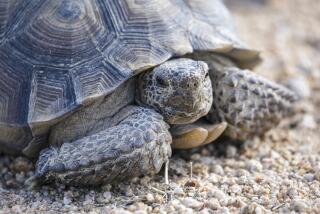A secret oasis for the world’s most endangered turtles
- Share via
Reporting from Ventura, Calif. — When it comes to caring for the world’s rarest cold-blooded animals, few places match the pampering and security provided to hundreds of critically endangered turtles and tortoises at a secret compound in the foothills of Los Padres National Forest.
In paddocks and aquariums protected by surveillance cameras and electric wire, Okinawa leaf turtles feast on silkworms and mulberries in a temperature-controlled greenhouse. Nest-building Burmese black mountain tortoises relax in piles of freshly cut oak, sycamore and bamboo. Forest-dwelling impressed tortoises dine exclusively on organically grown oyster mushrooms. Philippine pond turtles spend the night in snug tunnels made of cork bark.
But Saturday’s VIPs were eight ploughshare tortoises flown in from Hong Kong in padded crates. Among them is a female of breeding age, which Eric Goode and his associates at the nonprofit Turtle Conservancy’s Behler Chelonian Center hope to mate with the only male ploughshare tortoise of breeding age in North America.
“That male, which is en route from a zoo in Texas, hasn’t seen a female ploughshare tortoise of breeding age in more than 25 years,” Goode said as he marveled at the new arrivals in a quarantined pen. “We’re hoping for the best. These creatures have seen nothing but bad luck, corruption and greed in captivity.”
Some would call that an understatement. With fewer than 300 left in the wilds of Madagascar, the ploughshare tortoise holds the dubious distinction of being the rarest tortoise on Earth. They are heavily targeted by global animal traffickers, and the high-domed creatures fetch tens of thousands of dollars on the Asian black market, conservationists say.
Until recently, attempts to breed the ploughshare tortoise outside of Madagascar failed miserably. In the early 1980s, a male died shortly after zoo workers in Honolulu used an electric device to procure semen from the animal. A female that it was supposed to have mated with had her ovaries removed during a botched operation.
“Given their plight and scarcity, it took more than a decade of hard work by us, the Durrell Wildlife Conservation Trust, and Hong Kong authorities and conservationists to get these eight tortoises into our compound,” said Paul Gibbons, managing director of the Behler Chelonian Center. “But, then, a lot of the animals in our pens have similar stories to tell.”
Many of the species found on the compound are nearing extinction because of habitat loss, wildfires, hunting and black markets.
“International animal trafficking is a dark and dangerous subculture,” Goode said. “Certain dealers will go to great extents to get their hands on these animals. That is why, although we are certified by the American Zoo and Aquarium Assn., we are not open to the public.”
There is no sign outside the facility, nor is it listed in the phone book. “Theft is a reality,” Goode said. “The only visitors are turtle biologists from around the world.”
The conservancy was established in 2005 with 250 rare turtles transferred from a Bronx Zoo collection that had been housed at Saint Catherines Island off the coast of Georgia. Today, the conservancy mostly manages animals seized from illegal trafficking operations or bred in its rock-and-mortar outdoor pens.
The conservancy’s primary mission is to maintain “assurance colonies” of threatened and endangered tortoises and freshwater turtles, such as the four Galapagos tortoises that lumbered across a manicured lawn in a pen shaded by tropical plants and oaks Saturday.
It also lends some of its reptiles to zoos around the world and collaborates with conservationists to protect the rarest species from extinction. For example, the conservancy has been working with biologists in the United States and Mexico to revive bolson tortoise populations in the hot and thorny Chihuahuan Desert south of the Rio Grande Valley.
Once as plentiful as jackrabbits, only an estimated 5,000 bolson tortoises survive today. Cactus fruit is the bolson’s dish of choice, and it’s always on the menu at the conservancy.
“We specialize in creating environments that are peaceful and natural as possible for our turtles,” Goode said.
More to Read
Sign up for Essential California
The most important California stories and recommendations in your inbox every morning.
You may occasionally receive promotional content from the Los Angeles Times.











